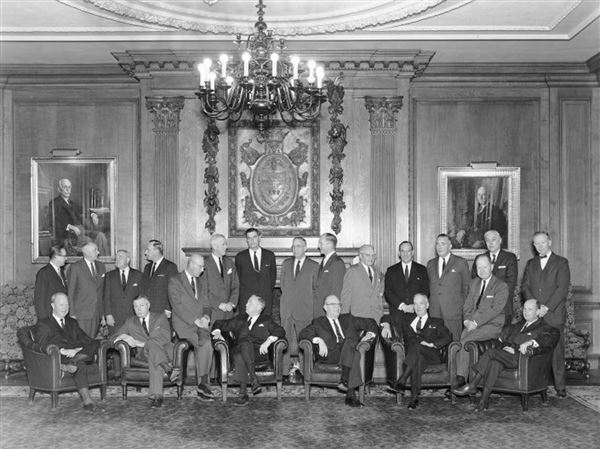My foodie family’s favorite new Internet TV show (“obsession” is more like it) takes historic eating to a new level. As we’ve discovered, it’s fiendish fun — not to mention quite educational — to see what it might’ve been like to live and eat in another time. But instead of downing an entire flagon full of hot, fermented oatmeal by yourself, you can keep your mouth free for squealing by watching two hilarious British people drink it for you.
In the BBC show “The Supersizers Go…,” self-professed libertine restaurant critic Giles Coren and sarcastic vegetarian broadcaster Sue Perkins explore various eras in Britain’s history together by living them, one week at a time, dining on typical fare and wearing the popular fashions of the day.
“The Supersizers Go…” debuted as a special called “Edwardian Supersize Me” in 2007, right after the documentary “Super Size Me,” but soon branched out into its own interesting and hilarious territory. (A renamed remixing of the same ideas, “The Supersizers Eat…,” was aired in six episodes afterwards as well.) In the 12 episodes (two seasons) of “The Supersizers Go…,” the pair cover eras from ancient Rome to WWII and the Victorian era to Elizabethan times — even the 1970s and 1980s. For each episode, the show’s staff scouts a house that looks like one from that era and creates all the costumes and food in epic detail. Ms. Perkins and Mr. Coren live the entire week as people of the past, then compare before-and-after health-test results to see how it has affected their bodies (and their sanity).
Each episode contains numerous nuggets of real-life detail that history lovers will find more memorable than the stench that emanates from a clay pot of garum (the fermented fish sauce featured in the “Ancient Rome” episode) that’s been left in the sun.
Episodes about days long past tend to feature the animal bounty of nature in all its colorful, smelly glory, while the modern era episodes are heavy on new processed foods such as the powdered eggs and “special margarine” of the 1940s and the classic reconstituted pudding known as Angel Delight in the 1970s.
Along the way, you’ll learn about popular foods of years past that many people of today probably couldn’t swallow, such as:
• Skilly, a hated World-War II soup made from grated carrots and home-grown oatmeal
• Cake baked with paraffin instead of oil
• Snipe heads (you suck out its tiny brain, then pick your teeth with its long, pointy beak)
• Giant coxcombs
• Tinned meats, courtesy of the Victorian Navy
• A pile of bird tongues
• Fried calves’ ears
• Cheese crawling with edible maggots, mites, and grubs
The amount of alcohol consumed in bygone days also might shock some modern viewers. Even the booze-loving Mr. Coren gets sick and sweaty trying to keep up with the daily alcohol portions in the Restoration era, when babies went straight from breast milk to beer and the fork was a new invention that looked like something on which you might spear a weenie.
And in the 1970s, when Ms. Perkins and Mr. Coren host a party, they take the advice of a recent entertaining guide to budget half a bottle of liquor per guest, every two hours — then increase it to three-quarters of a bottle after two hours if people haven’t yet gone home.
By measuring the consequences to their bodies before and after each week, the Supersizers prove how fast most people of bygone days would have developed conditions such as gout, taxed livers, overstimulated gallbladders, and even issues such as tansy poisoning: the depression and paranoia that resulted from eating the delicious herb, which was used during the Restoration as an omelette flavoring. In most episodes, the doctors say things such as, “Severe constipation is something you can expect in the next week.”
It’s easy to wince while watching this show, but history — especially the history of food — is nothing if not a perspective adjustor. In fact, this might be just the thing to help your finicky 14-year-old uncover new feelings of gratitude for the luxury and conveniences of modern life.
For foodies and history nerds of all ages, the appeal of the show is undeniable — but the “Supersizers” and their exploits seem to be able to bring out a little of those qualities in almost anyone. My frugal home-cook mother, my gourmet brother in Los Angeles and my other brother, a hungry West Virginia college student who loves history, all are devoted “Supersizers” watchers, trading tidbits from favorite episodes on every long-distance phone call. Even my 90-year-old grandmother seems delighted as she squeals in response to the bizarre meats the “Supersizers” eat — then wags her finger, intoning, “My mother used to cook stuff like that, you know!”
“The Supersizers Go…” is available free on Hulu.com. (It can also be watched via Hulu Plus for phones, Nintendo Wiis and other portable devices.)
Celanie Polanick is a writer, editor and graphic designer (and lifelong Pittsburgher) who loves cooking and children's media.
BBC photos
First Published: July 3, 2015, 12:25 a.m.
















